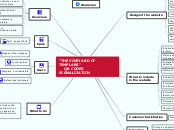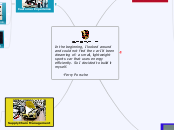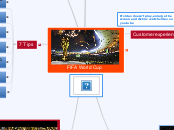Welcome!
Welcome!
This Smart Map helps you to outline the plan for an Agile project. The wizard shows you the basic principles, so that you can then leave the wizard behind and continue to develop the map as a regular Mindomo map.
The purpose of using a Mindomo map is to create a focus for discussion and explanation, which is an important principle of Agile. You can use the map to discuss and explain stories, specifications, features and plans. The map aims to capture an accurate description of the work to be done, but does not manage the project around it.
"THE VINEYARD OF TEMPLARS"
QR CODES SIGNALIZATION
Add your project name
Begin by typing in the name of your project, then press Enter.
What to do
Stories
Stories are the heart of an Agile plan. They describe something that can be tested, delivered and actually used by Users.
When adequately defined, Stories can be moved to belong to a Sprint below. A Sprint is a group of Stories that build a working part of a solution.
Just add a couple of user stories here to establish the idea. You can add more later.
As a tourist, I would like to have the information given during the visit, so that I can consult it once again and even buy a product at the moment or in the future.
Add a user story
Type in a user story, in the following format:
'As a [A], I need to [B], so that I can [C]'
where:
[A] is a user role,
[B] is what the user needs to do, and
[C] is why they need to do it.
Example: 'As a registered user, I need to be able to change my password, so that I can manage security'.
Click on an icon to rank the importance of this Story:
- Essential - must be delivered in the project
- Preferred - should be included if possible
- Optional - include only when all essential and preferred items are complete
Design signalitzation points for the activity
Design a QR code
Design a platform or webpage where the information will be reflected
Collect all the information in a formal document
Add a feature, function or task
What features, functions or tasks will be needed to deliver this story in a working form? What components must be working? What needs to be researched and designed?
Add an item and press Enter. Just add a few to get the idea - you can add more later when editing the map as a Mindomo map.
4 story points
How complex is this story?
Estimate the relative complexity of this story, expressed as story points. Trivial things are only a point or two, and average is about 5 points. If you find it hard to guess, you may need to break it down further into smaller stories.
Make your selection and press Enter.
1 story point (easy)2 story points3 story points5 story points (average)8 story points13 story points (hard)More than 13 story points
Users
Define your users
Next, we will make a list of Users. These are the people who will interact with the solution that you are creating. They will have reasons for wanting to use the solution, and expectations of what it should and should not do. Users are identified not by personal name, but by their role in relation to the task they perform.
For the purposes of this wizard, just enter a couple of user roles to establish the idea. You can add more later.
Professional designers
Company's collaborators
Tourist guides
Owners of the company
Add a User role
Type in a User role and press Enter. Typical roles for an IT solution might be:
- Unregistered users
- Registered users
- Users with special privileges
- Support staff
- Sales staff
- System administrators
- Hackers
Epics
Epics
Epics are the major stages in a project, and are divided up into sprints.
An epic is often a product release point or a handover to the customer.
You will probably already have a good idea of the major milestones in your project. You do not need to fully plan them here and now, as you can modify them later on.
April - August 2016
Add an Epic
Add an Epic (major project phase) to the map. If you have a target date in mind, include it in the topic text for clarity.
Overview
Summarise your project
We will begin with a summary of the key points of your project, to act as a reference for discussions.
D.O Penedès invests in implementation of QR codes around the region
No feeback between customers, company and collaborators
Interested customer without fisical informational support
"The vineyard of Templers" will be the activity where we will introduce a new technologial information system.
Add a key point about your project
Add a key point about your project. Consider:
- Who is the customer?
- Who is delivering the project?
- Why is this project needed?
- Who are the users?
- What are the core objectives?
Signaling
Simple but attractive design
Professional designer
Ecologic support materials
Few information + QR codes
Customer Satisfaction
Newsletter
What to include
in the website
Documentary sources
Pictures and videos
Information of the company’s products tasted (mono+500)
Information of the centenary bakery and their products
Introduction to Pla de Manlleu
History of Selma and legends
Explanation of the vineyards and their varieties
Vision and Mission of Vitiexperiencies+500
Introduction of Penedès and +500 territory
Design of the website
Section dedicated to customers opinions and comments
Survey
One section dedicated to book other experineces
One section dedicated to buy products
Linked sources
Colourful
Information displayed in diferents sections according to the tour stops.
All the pictures and videos
Vineyards of Templars +500 wallpaper









